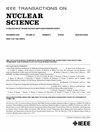Electrical Properties and Gain Performance of 4H-SiC LGAD (SICAR)
IF 1.9
3区 工程技术
Q3 ENGINEERING, ELECTRICAL & ELECTRONIC
引用次数: 0
Abstract
The 4H-SiC material exhibits good detection performance, but there are still many problems like signal distortion and poor signal quality compared with silicon. The 4H-SiC low-gain avalanche detector (LGAD) device can effectively improve the signal-to-noise ratio and signal quality due to the presence of internal amplification. A 4H-SiC low-gain avalanche detector has been fabricated and named SIlicon CARbide (SICAR). The results of electrical characteristics and charge collection performance of the 4H-SiC LGAD are reported. The influence of different metal thicknesses on the leakage current of the device is studied. By optimizing the fabrication process, the leakage current of the detector is reduced by four orders of magnitude. Experimental results confirm that this 4H-SiC LGAD exhibits a distinct gain structure. The gain factor was analyzed using4H-SiC LGAD (SICAR) 的电气特性和增益性能
4H-SiC 材料具有良好的探测性能,但与硅材料相比,仍存在信号失真、信号质量差等诸多问题。4H-SiC 低增益雪崩探测器(LGAD)器件由于存在内部放大,可以有效提高信噪比和信号质量。我们制作了一种 4H-SiC 低增益雪崩探测器,并将其命名为 SIlicon CARbide (SICAR)。报告了 4H-SiC LGAD 的电气特性和电荷收集性能。研究了不同金属厚度对器件漏电流的影响。通过优化制造工艺,探测器的漏电流降低了四个数量级。实验结果证实,这种 4H-SiC LGAD 具有独特的增益结构。该研究为高能粒子物理领域的应用提供了一种新型 4H-SiC LGAD 辐射探测器。
本文章由计算机程序翻译,如有差异,请以英文原文为准。
求助全文
约1分钟内获得全文
求助全文
来源期刊

IEEE Transactions on Nuclear Science
工程技术-工程:电子与电气
CiteScore
3.70
自引率
27.80%
发文量
314
审稿时长
6.2 months
期刊介绍:
The IEEE Transactions on Nuclear Science is a publication of the IEEE Nuclear and Plasma Sciences Society. It is viewed as the primary source of technical information in many of the areas it covers. As judged by JCR impact factor, TNS consistently ranks in the top five journals in the category of Nuclear Science & Technology. It has one of the higher immediacy indices, indicating that the information it publishes is viewed as timely, and has a relatively long citation half-life, indicating that the published information also is viewed as valuable for a number of years.
The IEEE Transactions on Nuclear Science is published bimonthly. Its scope includes all aspects of the theory and application of nuclear science and engineering. It focuses on instrumentation for the detection and measurement of ionizing radiation; particle accelerators and their controls; nuclear medicine and its application; effects of radiation on materials, components, and systems; reactor instrumentation and controls; and measurement of radiation in space.
 求助内容:
求助内容: 应助结果提醒方式:
应助结果提醒方式:


